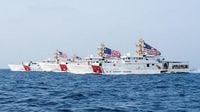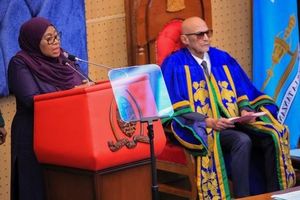The U.S. Coast Guard is charting a bold new course for its future with a major expansion of its fleet, following the announcement that it has exercised a contract option with Bollinger Shipyards of Lockport, Louisiana, for the construction of 10 additional Fast Response Cutters (FRCs). This $507 million agreement, revealed on September 11, 2025, marks a significant milestone in the Coast Guard’s ongoing modernization efforts, as reported by multiple industry and government sources.
The move, made possible by the passage of the One Big Beautiful Bill Act (Public Law 119-21), increases the total number of FRCs under the current agreement from 67 to 77 vessels. The act itself is a historic piece of legislation, allocating nearly $25 billion to the Coast Guard—the largest single funding commitment in the service’s history. Of this, $1 billion is specifically earmarked for the acquisition of additional FRCs, underscoring the government’s commitment to strengthening U.S. maritime security.
Rear Admiral Mike Campbell, the Coast Guard’s Director of Systems Integration and Chief Acquisition Officer, described the development as “a historic accomplishment for the Service.” He emphasized the FRC’s proven track record since its introduction to the fleet in 2012 as the successor to the 110-foot Island class patrol boat. “The Fast Response Cutter has consistently proven its capabilities, adaptability and effectiveness in a wide range of maritime environments and Coast Guard missions,” Campbell said, as cited by official Coast Guard communications.
The Sentinel-class FRCs are at the heart of the Coast Guard’s mission to secure U.S. maritime borders and respond to a host of challenges on the water. According to the Coast Guard, these vessels are designed for a variety of vital tasks: drug and migrant interdiction, ports, waterways and coastal security, fishery patrols, and search and rescue operations. With 59 cutters currently in service, the FRCs are gradually replacing the aging fleet of 1980s-era Island-class patrol boats, bringing new technology and versatility to the force.
Each Sentinel-class cutter is a marvel of modern engineering, measuring 154 feet (46.9 meters) in length and capable of reaching a flank speed of 28 knots. The ships are equipped with advanced command, control, communications, computers, intelligence, surveillance, and reconnaissance (C4ISR) suites, as well as a stern launch and recovery ramp for a 26-foot (7.92-meter) over-the-horizon interceptor cutter boat. In terms of firepower, each vessel boasts a 25mm autocannon and four 12.7mm machine guns, ensuring that the Coast Guard remains prepared for a wide range of threats and missions.
Ben Bordelon, CEO of Bollinger Shipyards, highlighted the longstanding partnership between his company and the Coast Guard. “With this award, the Coast Guard is doubling down on a proven platform and a proven team. Our workforce has delivered nearly 200 cutters, including 60 FRCs, in our more than 40-year partnership with the Coast Guard,” Bordelon stated, as reported by industry publications. This collaboration has not only enhanced national security but also provided a significant economic boost to Southeast Louisiana and beyond.
The FRC program’s economic impact is nothing to sneeze at. Material spending for the cutters has exceeded $2 billion since the program’s inception. According to data provided by the Coast Guard and Bollinger Shipyards, the initiative supports more than 650 jobs directly in Southeast Louisiana and has indirectly created 1,690 jobs through operations and capital investment. The annual GDP impact from the program is estimated at $202 million, demonstrating the broad reach of federal investment in maritime infrastructure.
The first FRC funded through this new contract option is expected to be delivered in fiscal year 2028. This timeline will ensure uninterrupted deliveries to meet the Coast Guard’s operational demands, aligning with the Force Design 2028 initiative—a strategic plan aimed at transforming the service into a more agile and capable fighting force for the coming decades.
But the Coast Guard’s ambitions don’t stop with the FRC program. Bollinger Shipyards is also leading the construction of the Coast Guard’s Polar Security Cutter (PSC) program, which has recently secured full funding for the advanced procurement and construction of vessels two and three. Thanks to the One Big Beautiful Bill Act, the PSC program now has $4.3 billion in funding, making it fully resourced to deliver the first new heavy American-built icebreakers in nearly 50 years. After acquiring the troubled program in 2022, Bollinger has invested heavily in its Mississippi facilities and workforce, stabilizing the project and putting it back on track for delivery. The first PSC is anticipated by May 2030, according to Coast Guard officials.
It’s worth noting that the FRCs are more than just new ships—they represent a leap forward in technology and capability. The inclusion of the C4ISR suite and over-the-horizon cutter boat deployment capabilities gives the Coast Guard unprecedented flexibility and reach. Whether interdicting illicit drugs, rescuing mariners in distress, or safeguarding fisheries, these vessels are designed to meet the evolving challenges of the maritime domain head-on.
For the communities along the Gulf Coast, the contract means more than just enhanced national security. It translates into stable jobs, local investment, and a sense of pride in contributing to the nation’s defense. The ripple effects of the Coast Guard’s investment in Bollinger Shipyards are felt in small businesses, schools, and neighborhoods across Southeast Louisiana and Mississippi.
As the Coast Guard prepares for the future, the expansion of the FRC fleet and the advancement of the PSC program signal a renewed commitment to maritime readiness and resilience. With the first of the new FRCs slated for delivery in 2028 and the first PSC expected by 2030, the service is positioning itself to tackle the challenges of an increasingly complex maritime environment.
In the words of Rear Admiral Campbell, these developments are not just about new ships—they’re about ensuring that the Coast Guard remains “adaptable and effective” in fulfilling its mission. For Bollinger Shipyards and the thousands of workers whose livelihoods depend on these programs, the message is clear: the future of American maritime security is being built right here, one cutter at a time.




